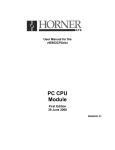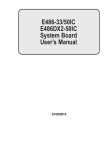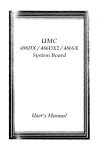Download DFI 486-OCV Plus User`s manual
Transcript
486-OCV Plus System Board User’s Manual - D21840429 - v Copyright 1994, by DFI Inc. All rights reserved. No part of this document may be copied or reproduced in any form or by any means without the prior written consent of DFI, Inc. DFI, Inc. makes no warranties with respect to this documentation and disclaims any implied warranties of merchantability, quality, or fitness for any particular purpose. The information in this document is subject to change without notice. DFI, Inc. reserves the right to make revisions to this publication and to make changes to any and/or all parts of its content, at any time, without obligation to notify any person or entity of such changes. Further, DFI, Inc. assumes no responsibility for any errors that may appear in this document. DFI is a registered trademark, and 486-OCV Plus is a trademark of Diamond Flower, Inc. All other product names mentioned are trademarks or registered trademarks of their respective companies. v Table of Contents v Introduction ................................................................................. 1-1 Features and Specifications ................................................. 1-2 2-1 2-1 2-2 2-2 2-2 2-2 2-6 2-7 2-8 2-8 Installation Overview ................................................................. Preparing the Area ................................................................ Handling the System Board .................................................. Tips in Handling the System Board ............................... Hardware Installation ............................................................. Memory Installation ......................................................... Installing the Modules .............................................. Board Configuration ........................................................ Jumper Settings ....................................................... Jumper Settings for VL-Bus Add-On Board ..... Jumper Settings of Internal/External/CMOS Clean, Display Type and Diagnostic/ Password Clear .................................................. Cache Configuration ................................................ Jumper Settings for Cache Memory ................. CPU Installation and Upgrade ....................................... CPU Configuration .................................................. Jumper Settings for CPUs ................................. Installing Upgrade CPUs ........................................ Installing the System Board .................................................. 2-11 2-14 2-16 2-18 2-18 2-19 2-22 2-26 Initial Setup Program ................................................................. AMI BIOS Setup Utilities ....................................................... Standard CMOS Setup .................................................. Advanced CMOS Setup ................................................. Auto Configuration with BIOS Defaults ......................... Auto Configuration with Power-on Defaults .................. 3-1 3-2 3-3 3-5 3-7 3-7 Change Password ......................................................... Auto Detect Hard Disk .................................................. Hard Disk Utility ............................................................. Write to CMOS and Exit ................................................ Do not write to CMOS and Exit .................................... 3-8 3-9 3-10 3-11 3-11 Troubleshooting Checklist ...................................................... 4-1 Appendix A: Types of Modules .............................................. Appendix B: System Error Report ......................................... Appendix C: Memory & I/O Maps ........................................... Appendix D: 16-Bit ISA I/O Pin Assignments ....................... Appendix E: VL-Bus I/O Pin Assignments ........................... Appendix F: System Overview ............................................... Appendix G: Connector Pin Assignments ............................ Appendix H: AMI BIOS Hard Disk Table ............................... A-1 B-1 C-1 D-1 E-1 F-1 G-1 H-1 486-OCV Plus v Introduction The 486-OCV Plus system board is designed so that it may be equipped with Intel's 80486DX, 80486DX2, 80486SX, and 80486 OverDriveTM Processors which can run from speeds of 25MHz to 66MHz. It may also use a PentiumTM OverDrive Processor running at 50MHz or 66MHz. This Pentium-based system board is twice as fast as the 80486DX-33 and accommodates almost all of the existing programs designed for 386 or 486-based systems. The system board also supports a Cyrix or AMD 486DX CPU running at 40MHz. The 486-OCV Plus is a jumperless-upgrade board allowing you to easily upgrade your CPU from a 486SX to 486DX or DX2 for example, without altering any jumpers. However, if you change your CPU speed from 25MHz to 33MHz, 40MHz or 50MHz, or change a Cyrix CPU to an Intel or AMD CPU, you may have to alter a few jumpers. The 486-OCV Plus is equipped with a Zero Insertion Force socket to make upgrading your CPU easy. It also supports an optional Flash EPROM. Flash EPROM is a memory chip for the storage of BIOS which can be erased in bulk or modified using a software utility. The 486-OCV Plus system board is also equipped with two VESA compliant local bus slots. The VL-Bus of the 486-OCV Plus system board operates at the same frequency (up to 40MHz) and phase as the CPU, supporting all DMA and system I/O bus mastering cycles. Introduction u 1-1 PentiumTM OverDrive Ready System Board The 486-OCV Plus uses 256Kx36, 512Kx36, 1Mx36, 2Mx36, 4Mx36 and 8Mx36 HSIM modules with speeds of at least 80ns. The memory can be configured to twenty-one different sizes from 1MB to 64MB. The system is equipped with two 32-bit VESA VL-Bus and eight 16-bit ISA expansion slots. Features and Specifications • Intel 80486DX running at 33/40/50MHz, 80486DX2 running at 50/66MHz, 80486 OverDriveTM Processor, PentiumTM OverDrive Processor running at 50/66MHz, or 80486SX running at 25/33MHz Cyrix or AMD 486DX running at 40MHz • Uses AMI BIOS: 27512-20 (1) • Uses OPTi 82C499 chip set • Cache organization: direct map, write back and bank interleave • Supports 64K, 128K and 256K cache sizes • Memory configurable from 1MB to 64MB • Uses 256Kx36, 1Mx36 and 4Mx36 HSIMM Uses 512Kx36, 2Mx36 and 8Mx36 (for Banks 0 and 2 only) • Supports memory with parity check • 8MHz bus clock • Software programmable cache and DRAM wait states • Supports system BIOS and Video BIOS Shadow RAM function • Supports sixteen edge triggered interrupts • Hidden refresh or slow refresh supported • Optional Flash memory BIOS supported • Supports PentiumTM OverDrive Processor Zero Insertion Force socket • Supports one PS/2 mouse port • An optional diagnostic LCD port 1-2 u Introduction 486-OCV Plus • Supports VESA VL-Bus devices (2 VESA Master/ Slave) ISA DMA Master access to local device Local Master access to an ISA device Fully compatible with VESA VL-Bus rev. 1.0 • Two 32-bit VL-Bus and eight 16-bit ISA slots • Maximum card length Full-length cards in all VL-Bus slots and in three ISA slots 9.75" cards in three ISA slots • Four layer PCB • Baby AT size • Operating temperature: 0oC - 40oC • One year limited warranty Warning: If your 486-OCV Plus system board is using a 486DX 50 CPU, we recommend that you do not install any VL-Bus devices. The VL-Bus connectors, compliant with VESA VL-Bus standard rev. 1.0, limit the speed of a VL-Bus device operating across the connector (e.g. an add-on board) to 40MHz. The table below, based on the VESA VL-Bus specification, shows the recommended number of installed VL-Bus devices at various CPU speeds. This table is only a recommendation, not a requirement. Any VL-Bus add-on board must correspond with the CPU speed, whether it is buffered or unbuffered. CPU Speed <= 33MHz 40MHz >= 50MHz Unbuffered Buffered 2 slots/2 devices 3 slots/3 devices 1 slot/2 devices not recommended 0 slot/2 devices not recommended Introduction u 1-3 PentiumTM OverDrive Ready System Board v Installation Overview This chapter summarizes the steps in installing the 486-OCV Plus system board into your system unit. It also includes a description of the area in which you must work and directions for memory installation. Before installing the system board, obtain the memory you plan to install. Preparing the Area Before unpacking the system board, make sure the location you have selected is relatively free of dust and static. Excessive exposure to dust, static electricity, direct sunlight, excessive humidity, extreme cold and water can damage the operational capabilities of your system board. Avoid soft surfaces such as beds and carpeted floors which can hinder air circulation. These areas also attract static electricity which can damage some circuits on your system board. Be sure that the power source has a properly grounded, three-pronged socket. It is essential that the power connection be properly grounded for correct functioning of your system board. For further protection, we recommend that you use a surge protection socket. This will protect the system board from damage that may result from a power surge on the line. Move items that generate magnetic fields away from your system board, since magnetic fields can also damage your system board. Once you have selected the ideal location, unpack the 486-OCV Plus system board carefully. 2-1 u Installation Overview 486-OCV Plus Handling the System Board It is quite easy to inadvertently damage your system board even before installing it to your system unit. Static electrical discharge can damage computer components without causing any signs of physical damage. You must take extra care in handling the system board to ensure that no static build-up is present. Tips in Handling the System Board 1) To prevent electrostatic build-up, leave the board in its anti-static bag until you are ready to install it. 2) Wear an antistatic wriststrap. 3) Do all preparation work on a static-free surface with components facing up. 4) Hold the system board by its edges only. Be careful not to touch any of the components, contacts or connections, especially gold contacts on the board. 5) Avoid touching the pins or contacts on all modules and connectors. Hold modules and connectors by their ends. Hardware Installation Memory Installation The 486-OCV Plus system board can support 1MB to 64MB of memory using HSIMMs. HSIMM is an acronym for High Density Single In-line Memory Module. Installation Overview u 2-2 PentiumTM OverDrive Ready System Board An HSIMM consists of several RAM chips soldered onto a small circuit board. An HSIMM connects to the system board via a 72-pin card-edge connector. The HSIMM sockets are divided into four banks on the system board. The 486-OCV Plus system board uses 256Kx36, 512Kx36, 1Mx36, 2Mx36, 4Mx36 and 8Mx36 HSIM modules. Note: The 8Mx36 HSIM module must be the standard size module. Mechanical problem may occur if a longer size of module is installed. You will need 1 to 4 pieces of HSIM modules, depending on the amount of memory you intend to install. Your system board can be configured with 1MB, 2MB, 4MB, 5MB, 6MB, 8MB, 9MB, 12MB, 13MB, 16MB, 18MB, 20MB, 24MB, 28MB, 32MB, 34MB, 36MB, 40MB, 48MB, 52MB or 64MB of onboard memory. To install the HSIM modules, first populate Bank 0, then Bank 1 and so on. Failure to do so will cause the system board to work improperly. The following table summarizes the bank locations and modules needed for the corresponding memory sizes. Each bank consists of 1 HSIMM socket. 2-3 u Installation Overview 486-OCV Plus Memory Size Bank 0 Bank 1 Bank 2 Bank 3 1MB 2MB 2MB 4MB 5MB 6MB 6MB 8MB 8MB 9MB 9MB 12MB 12MB 13MB 13MB 16MB 16MB 16MB 18MB 18MB 20MB 20MB 24MB 24MB 24MB 24MB 28MB 28MB 28MB 28MB 28MB 28MB 32MB 32MB 256Kx36 256Kx36 512Kx36 1Mx36 256Kx36 256Kx36 512Kx36 1Mx36 2Mx36 1Mx36 2Mx36 1Mx36 2Mx36 256Kx36 256Kx36 1Mx36 2Mx36 4Mx36 256Kx36 512Kx36 1Mx36 4Mx36 1Mx36 2Mx36 1Mx36 4Mx36 1Mx36 2Mx36 1Mx36 1Mx36 4Mx36 4Mx36 4Mx36 8Mx36 256Kx36 1Mx36 256Kx36 1Mx36 1Mx36 1Mx36 1Mx36 1Mx36 1Mx36 256Kx36 4Mx36 1Mx36 1Mx36 4Mx36 1Mx36 1Mx36 4Mx36 4Mx36 1Mx36 1Mx36 4Mx36 - 1Mx36 1Mx36 256Kx36 256Kx36 1Mx36 1Mx36 1Mx36 2Mx36 1Mx36 2Mx36 4Mx36 4Mx36 4Mx36 4Mx36 1Mx36 1Mx36 4Mx36 4Mx36 1Mx36 2Mx36 1Mx36 2Mx36 - 1Mx36 1Mx36 1Mx36 1Mx36 1Mx36 1Mx36 - Installation Overview u 2-4 PentiumTM OverDrive Ready System Board Memory Size Bank 0 Bank 1 Bank 2 Bank 3 34MB 34MB 36MB 36MB 36MB 36MB 40MB 40MB 40MB 40MB 40MB 40MB 48MB 48MB 52MB 52MB 52MB 52MB 52MB 52MB 64MB 64MB 256Kx36 512Kx36 1Mx36 4Mx36 4Mx36 8Mx36 1Mx36 2Mx36 1Mx36 4Mx36 4Mx36 8Mx36 4Mx36 8Mx36 1Mx36 1Mx36 4Mx36 4Mx36 4Mx36 8Mx36 4Mx36 8Mx36 256Kx36 4Mx36 1Mx36 4Mx36 1Mx36 4Mx36 1Mx36 4Mx36 4Mx36 4Mx36 4Mx36 1Mx36 1Mx36 4Mx36 4Mx36 - 4Mx36 8Mx36 4Mx36 4Mx36 1Mx36 1Mx36 4Mx36 8Mx36 4Mx36 4Mx36 1Mx36 2Mx36 4Mx36 4Mx36 4Mx36 8Mx36 4Mx36 8Mx36 4Mx36 4Mx36 4Mx36 8Mx36 4Mx36 4Mx36 1Mx36 1Mx36 1Mx36 4Mx36 4Mx36 1Mx36 1Mx36 4Mx36 - 2-5 u Installation Overview 486-OCV Plus OPTi 82C499 Pin 1 of the HSIMM socket Bank 0 Bank 1 Bank 2 Bank 3 Locations of the HSIMM Sockets on the System Board Installing the Modules HSIMMs simply snap into a socket on the system board. Pin 1 of the HSIMM must correspond with Pin 1 of the socket. Installation Overview u 2-6 PentiumTM OverDrive Ready System Board 1. Position the HSIM module above the HSIMM socket with the chips of the module facing the center of the system board. 2. Seat the module at an angle into the bank. Make sure it is completely seated. Tilt the module upright until it locks in place in the socket. Board Configuration The 486-OCV Plus is designed with jumpers and connectors onboard. Make sure that the jumpers are set correctly before installing the system board into your system unit. JP32 J1 JP18 JP39 J2 J3 JP29 J4 J5 SL1 JP23 J6 JP24 J7 JP38 JP6 SL2 J8 JP34 JP31 JP9 OPTi 82C499 JP7 JP8 JP25 JP26 JP12 JP14 JP13 Locations of Jumpers and Connector Pins on the 486-OCV Plus System Board 2-7 u Installation Overview J10 J11 J9 486-OCV Plus Jumper Settings Jumper Settings for VL-Bus Add-On Board If a VL-Bus add-on board is installed in the 486-OCV Plus system board, make sure Jumpers JP18, JP23, JP24 and JP34 are set correctly. JP18 JP23 JP24 JP34 OPTi 82C499 Locations of Jumpers JP18, JP23, JP24 and JP34 on the 486-OCV Plus System Board Installation Overview u 2-8 PentiumTM OverDrive Ready System Board Jumper JP23 High Speed Mode for VL-Bus Board Set Jumper JP23 to Off only if the VESA VL-Bus add-on board installed in the VL-Bus slots support Zero Wait State. If you are not sure that your add-on board(s) support Zero Wait State, set JP23 to On; otherwise, a system error may occur. On: One Wait State Off: Zero Wait State Jumper JP24 CPU Speed for VL-Bus Board If a VL-Bus board is installed in the 486-OCV Plus system board, Jumper JP24 must be set to On if the CPU speed is greater than 33MHz. If the CPU speed is less than or equal to 33MHz, set JP24 to Off. On CPU Speed > 33MHz 2-9 u Installation Overview Off CPU Speed <= 33MHz 486-OCV Plus Jumper JP18 VL-Bus Ready Signal Select If a VESA VL-Bus add-on board is installed in either one of the VL-Bus slots and the 486-OCV Plus system board is using a 486-50DX CPU, we recommend that you set Jumper JP18 to "Delay 1 PCLK". Your system board might not work properly if Jumper JP18 is set to "No Delay". 1 2 3 1-2 On: Delay 1 PCLK (Default) 1 2 3 2-3 On: No Delay Jumper JP34 VL-Bus Address Select If the 486-OCV Plus system board is using a 40MHz or 50MHz 486DX CPU, VESA VL-Bus add-on boards may not work when Jumper JP34 is set to "No Delay". In this case, we recommend that you set Jumper JP34 pins 1-2 and 3-4 to On, "Delay 1 PCLK". Set JP34 pins 2-3 to On if your system board is using a 386-25/33/40MHz or 486-25/33MHz CPU. If it is not set to these recommended settings, your system might hang. 1 2 3 4 1-2, 3-4 On: Delay 1 PCLK 1 2 3 4 2-3 On: No Delay (Default) Installation Overview u 2-10 PentiumTM OverDrive Ready System Board * If Jumper JP34 is set to Delay 1 PCLK, the 486-OCV Plus will only support one VL-Bus Master in Slot SL2. Jumper Settings of Internal/External/CMOS Clean, Display Type and Diagnostic/Password Clear Jumper J11 enables or disables the internal battery, external battery or CMOS Clean. JP29 allows you to select between a color or monochrome display. JP39 allows you to perform diagnostic test and clear the password. JP39 JP29 OPTi 82C499 Locations of Jumpers J11, JP29 and JP39 on the 486-OCV Plus System Board 2-11 u Installation Overview J10 J11 486-OCV Plus Jumper J11 Internal Battery/CMOS Clean Select The 486-OCV Plus comes with an internal battery. If there is a problem with the internal battery, or if you prefer to connect an external battery, set Jumper J11 pins 1-2-3 to Off and connect an external battery to Connector J10. 1 2 3 1-2-3 Off: External Battery Enable (Default) If, for some reason, the CMOS becomes corrupted, the system can be reconfigured with the default values stored in the ROM chips. To load the default values, set J11 pins 2 and 3 to On for approximately one to two days, then return to the default position. 1 2 3 1-2 On: Internal Battery Enable 1 2 3 2-3 On: CMOS Clean Note: After CMOS has been reset, you must either set the jumper to Internal or External battery enable. If you set the jumper to External battery enable, make sure you connect an external battery to Connector J10. Installation Overview u 2-12 PentiumTM OverDrive Ready System Board Jumper JP29 Display Type Select Jumper JP29 sets the display adapter to color or mono. This jumper must match the type of display adapter installed. If you change your video adapter, make sure that this jumper is changed accordingly. On: Color Display (Default) Off: Mono Display Jumper JP39 Diagnostic/Password Clear If you had enabled the Password Checking Option in the Advanced CMOS Setup and forgot your password, set Jumper JP39 to On. The 486-OCV Plus system board will perform diagnostic test and clear the password stored in your CMOS. Set JP39 to Off after you have cleared the password. On: Diagnostic/ Password Clear 2-13 u Installation Overview Off: Normal (Default) 486-OCV Plus Cache Configuration The 486-OCV Plus system board can be configured to three different cache sizes: 64KB, 128KB and 256KB. 128KB of cache memory is the default size. Either 8K x 8 (20ns) or 32K x 8 (20ns) chips are used for cache depending on the size of cache desired. Regardless of the amount of cache memory installed, one 8K x 8 (20ns), one 16K x 8 or one 32K x 8 (20ns) SRAM is needed for tag RAM to store the cacheable addresses. Because only one SRAM is installed for tag RAM, the cacheable system RAM size is dependent on the size of cache installed on your system board. The system board can automatically detect the cacheable system RAM size based on the size of cache installed in the 486-OCV Plus system board. The following table summarizes the cacheable system RAM size for the corresponding cache size. Cache Memory 64KB 128KB 256KB Cacheable System RAM Size 16MB and below 32MB and below 64MB (maximum memory) Important: When cache size is 64KB or 128KB, an 8K x 8 (20ns) SRAM should be inserted in socket U3 for tag RAM. When cache size is 256KB, use a 16K x 8 or 32K x 8 (20ns) SRAM. Installation Overview u 2-14 PentiumTM OverDrive Ready System Board U3 U14 U15 U16 U17 U19 U20 U21 U22 Locations of the SRAM Sockets on the 486-OCV Plus System Board Cache Size U14/U15/U16/U17 U19/U20/U21/U22 U3 64KB 128KB* 256KB 8K x 8 32K x 8 32K x 8 8K x 8 None 32K x 8 8K x 8 8K x 8 16K x 8 or 32K x 8 * Default setting 2-15 u Installation Overview 486-OCV Plus Jumper Settings for Cache Memory JP6 JP9 JP7 JP8 OPTi 82C499 Locations of Jumpers JP6-JP9 on the 486-OCV Plus System Board Installation Overview u 2-16 PentiumTM OverDrive Ready System Board Cache Memory Size Jumpers 64KB 128KB* 256KB JP6 JP7 JP8 JP9 Off Off 2-3 On 2-3 On On Off 1-2 On 1-2 On On On 2-3 On 2-3 On * Default setting On Off 1 1 2 2 3 3 2-3 On 1-2 On 2-17 u Installation Overview 486-OCV Plus CPU Installation and Upgrade The 486-OCV Plus is equipped with a Zero Insertion Force (ZIF) socket to make upgrading flexible and easy. Make sure the jumpers are set correctly before applying power, or you may damage the CPU or system board. CPU Configuration Location U8 of the 486-OCV Plus system board is a 237-pin ZIF socket for the Intel 486TM family of CPUs, 486 OverDriveTM Processors, and the PentiumTM OverDrive Processor. This makes upgrading easy and affordable. Location U26 is a 196-pin PQFP [Plastic Quad Flatpack Package] for 80486SX. U8 U26 ZIF Socket OPTi 82C499 Location of Pin 1 Locations of the CPU Sockets on the 486-OCV Plus Installation Overview u 2-18 PentiumTM OverDrive Ready System Board Jumper Settings for CPUs JP38 JP12 JP14 JP25 OPTi 82C499 JP13 Locations of Jumpers JP12-JP14, JP25 and JP38 on the 486-OCV Plus System Board Jumpers JP12-JP14 and JP25 Clock Selection These jumpers should be set to match the speed of the CPU installed on the 486-OCV Plus system board. 2-19 u Installation Overview 486-OCV Plus 486SX/DX-25, 486DX2-50, PentiumTM OverDrive Processor 50MHz 486SX/DX-33, 486DX2-66, PentiumTM OverDrive Processor 66MHz 486SX/DX-40 486DX-50 JP12 JP13 JP14 JP25 Off Off On 2-3 On On Off On 2-3 On On Off On Off Off On 1-2 On 1-2 On On 3 2 Off 1 2-3 On 3 2 1 1-2 On Jumper JP38 CPU Type Selection Jumper JP38 should be set to match the type of CPU installed on the 486-OCV Plus system board. On: Cyrix CPU Off: Intel/AMD CPU Installation Overview u 2-20 PentiumTM OverDrive Ready System Board The jumpers below are for factory testing only and should always be set to their default configurations. Reconfiguring these jumpers will cause problems with your 486-OCV Plus system board. JP26: 1-2 On JP31: 1-2 On JP32: BIOS ROM Type Select 1-2 On: Flash RAM 28F001BX-T 2-3 On: Flash RAM 28F010 or 64KB ROM 2-21 u Installation Overview 486-OCV Plus Installing Upgrade CPUs The 486-OCV Plus is equipped with a 237-pin Zero Insertion Force (ZIF) socket at location U8 of the system board. The 486-OCV Plus accommodates all of the Intel 486TM and 5V PentiumTM family of OverDrive processors, and Cyrix or AMD 486DX-40 CPU. The ZIF socket allows easy CPU upgrades and minimizes the chance of breaking off CPU pins. Warning: Open the socket only if actually installing an upgrade CPU. The warranty on the original CPU will be voided if the S/N seal is broken. Installation of an OverDriveTM Processor will not affect the original system warranty. The 237-pin ZIF socket consists of four rows of pin holes on each side. Zero Insertion Force (ZIF) Socket Installation Overview u 2-22 PentiumTM OverDrive Ready System Board Install the 80486SX, 80486DX, 80486DX2 or the 80486 OverDriveTM Processor, which only has three rows of pins, in the three inner rows of the socket. The outermost row of pin holes should be visible on all four sides of the socket when any of these CPUs is installed. The PentiumTM OverDrive Processor has four rows of pins on each side and should be installed so it covers all the pin holes of the ZIF socket. To install, simply move the handle upward. Remove the original CPU from the socket. If the board has an 486SX CPU soldered on at U26, you should leave it intact. Position the upgrade CPU above the socket. Make sure pin 1 of the CPU is aligned with pin 1 of the socket. Lower the chip until the pins are inserted properly in their corresponding holes. Pin 1 Pin 1 of the ZIF Socket 2-23 u Installation Overview 486-OCV Plus CPU Pin 1 Positioning the CPU Above the ZIF Socket Gently push the handle down until the handle locks into place. You will hear a click when the handle is secure. When you want to remove the chip, simply lift the handle and remove the chip. Warning: The cables (floppy drive, hard drive, CD-ROM, etc.) must be routed clear of the CPU with a minimum of 0.25" horizontal clearance to allow heat dissipation. A minimum of 1.4" vertical clearance (measured above the socket surface) must be kept free above the CPU. Do not run cables or other obstructions in this area. Installation Overview u 2-24 PentiumTM OverDrive Ready System Board Cable Adequate airflow for cooling must be provided over the CPU. For PentiumTM OverDrive Processors, the airflow must be adequate to keep the system temperature below 40oC, measured 0.5 inch above the CPU and assuming a room temperature of 25oC. 2-25 u Installation Overview 486-OCV Plus Installing the System Board Before installing the system board into your system unit, you should prepare the tools you will use: You will need: • one medium size, flat-bladed screwdriver • one medium Philips screwdriver Step 1 Unlock your system unit. Turn off the power and disconnect all power cords and cables. Step 2 Remove the system unit cover. Refer to the manufacturer's instructions if necessary. Step 3 Remove expansion cards seated in any of the expansion slots and detach all connectors from the old system board. Step 4 Loosen the screws holding the original system board and remove the board from the system. Save the screws. Installation Overview u 2-26 PentiumTM OverDrive Ready System Board Step 5 Insert the SIM modules into the SIMM banks on the 486-OCV Plus. The quantity and location of the SIM modules is dependent upon the memory configuration and type of modules you intend to use. Step 6 Set the corresponding jumpers. Step 7 Install the prepared 486-OCV Plus system board into the case and replace the screws. Step 8 Reinstall all cards and connectors and replace the system unit cover. Reconnect all power cords and cables. 2-27 u Installation Overview 486-OCV Plus v Initial Setup Program After you power up your system, the BIOS message appears on your screen and the memory count begins. After the memory test, the message below will appear on the screen if your CMOS Setup is correct: Enter CURRENT Password: The default password is AMI. You have three chances to type the correct password. If the password is still incorrect after the third try, the system will lock up. You must turn your system off and back on to restart it. You can change the password under the change password option. Refer to the "Change Password" section on page 3-8 for more information. A screen similar to the one shown below will appear. If the password option is disabled, you will directly access this screen. Initial Setup Program u 3-1 PentiumTM OverDrive Ready System Board AMI BIOS Setup Utilities If you want to change your CMOS setup, press <Del> when the message, "Hit <Del> if you want to run setup", appears on the screen. Again, if you enabled the password option, you will be prompted to the message below: Enter CURRENT Password: The default password is AMI. For information on how to change the password, refer to the "Change Password" section on page 3-8. After entering the correct password, the screen below appears. If the password option is disabled, you will directly access this screen. Use the arrow keys to highlight the option you want and hit the <ESC> key. Note: Before you access the setup utilities, a warning message will appear. 3-2 u Initial Setup Program 486-OCV Plus This message warns you that inappropriate modifications may cause problems. Press <Enter> to continue or <Esc> to abort. If the system fails after the setup procedure, power off the computer and turn it on again. Wait for the message, "Hit <Del> if you want to run setup", and press <Del>. Standard CMOS Setup If you highlight "Standard CMOS Setup" and press <Enter>, a screen similar to the one below will appear: Initial Setup Program u 3-3 PentiumTM OverDrive Ready System Board The upper right hand corner shows the base memory size and extended memory size of your system. You cannot alter these items; your computer automatically detects and displays them. The left side of the screen lists the modifiable parameters. You can change the date, time, hard disk drive (C and D), type of floppy drive (A and B), primary display, and keyboard options. The Daylight Savings function is intended for use in notebook computers and is not supported by the 486-OCV Plus, so it does not matter how it is set. On the lower right hand corner is a calendar that shows the current date. The box at the lower left provides information on each highlighted parameter. Navigation and menu selection instructions are located below the information box. Use the up or down arrow key to move between options. Once you have highlighted the option you wish to change, use the <Page Up> or <Page Down> key to view the available selections for that option. If you have added a hard drive, you must select the appropriate type for the drive. The 486-OCV Plus has 46 pre-set types and one user-definable type. The table in Appendix H gives a complete listing of the available drive types. Any given hard drive must be set to one specific drive-type number. Please refer to your hard drive documentation to find the appropriate type number. 3-4 u Initial Setup Program 486-OCV Plus If none of the pre-set types is appropriate for your hard drive, choose 47, which is the user-definable type. To use this type, highlight either hard disk C or D, depending on your hard drive configuration. Use the <Page Up> key until type 47 is showing. Fill in all the parameters as specified by the drive manufacturer. To move between parameters, hit the <Enter> key. When you are through making changes, press <Esc> to return to the main menu. Advanced CMOS Setup If you highlight "Advanced CMOS Setup" and press <Enter>, a screen similar to the following one will appear: Use the arrow keys to move the highlight bar to the options you wish to change or modify. Use the <Page Up> or <Page Down> keys to make the corresponding changes. Initial Setup Program u 3-5 PentiumTM OverDrive Ready System Board Set the password checking option to "Always" or "Setup" if you want to enable this option. Setting it to "always" will prompt you for a password every time you cold boot your system or access setup. When you set the option to "Setup", you will be prompted for a password only when trying to access setup. The Boot Sector Virus Protection option may be set to "enabled" or "disabled". When enabled, the BIOS issues a warning when any program or virus sends a Disk Format command or attempts to write to the boot sector of the hard disk drive. Note: Your system must have an American Megatrend Keyboard Controller BIOS, version F or later, for this option to work. If the changes made are incorrect, or you change your mind, press <F6> or <F7> to return to the default settings. Press <Esc> after making the changes to return to the main menu. 3-6 u Initial Setup Program 486-OCV Plus Auto Configuration with BIOS Defaults If, for some reason, the CMOS becomes corrupted, the system can be reconfigured with the default values stored in the ROM chips. The BIOS Setup default values should provide optimum performance for the system. You should use these values unless you are possibly having hardware problems. Highlight this option on the main menu and press <Enter>. The message below will appear. Load BIOS Setup Default Values from ROM Table (Y/N)? N Type "Y" and press <Enter> to return to the BIOS setup default values. After pressing <Enter>, you will be returned to the main menu. Auto Configuration with Power-on Defaults The Power-on defaults are similar to the BIOS Setup defaults. These defaults are the most stable values for the system and should be used if you are possibly having hardware problems. Highlight this option on the main menu and press <Enter>. The message below will appear. Load Power-on Default Values from ROM Table (Y/N)? N Type "Y" and press <Enter> to return to the Power-on default values. After pressing <Enter>, you will be returned to the main menu. Initial Setup Program u 3-7 PentiumTM OverDrive Ready System Board Change Password The default password is AMI. If you want to change the password, make sure you set the Password Checking Option to "Always" or "Setup" under Advanced CMOS Setup. If not, the error message below will appear on the screen: <Password Option> must be enabled in Advanced CMOS Setup Press any key to continue Use the arrow keys to highlight the Change Password Option and press <Enter>. The message below will appear. Enter Current Password: The preset password is AMI. Type AMI or the current password and press <Enter>. The message below will appear: Enter NEW Password: Type in the the new password. You are limited to six ASCII characters. If you type more than six characters, you will get the following error message: Error, press any key 3-8 u Initial Setup Program 486-OCV Plus Press any key on the keyboard to return to the message below: Enter NEW Password: Type in a password that is six characters long or shorter. When done, you will be asked to verify the new password: Re-enter NEW Password: Type in exactly the same password. Failure to do so will yield the error message shown below: Error, press any key If you receive this error, you will have to start all over. After typing in the new password, the message below will appear: New password installed Press the <Esc> key to return to the main menu. Auto Detect Hard Disk This option detects the hard disk parameters for the hard disk drives installed in your system. Highlight this option and press <Enter>. A screen similar to the following one will appear. Initial Setup Program u 3-9 PentiumTM OverDrive Ready System Board The screen displays the parameters detected and allows you to accept or reject the parameters. Type "Y" and press <Enter> to accept the parameters or press <Esc> to abort. If you select "Y", the parameters for hard disk Type 47 will be displayed in Standard CMOS Setup. If you select "N", the parameters in the Standard CMOS Setup will remain the same. Hard Disk Utility This option will format, set the interleave mode, and do a media analysis of your hard drives. Highlight this option and press <Enter>. A screen similar to the following one will appear. Note: DO NOT use this utility on IDE hard drives. Using this utility can severely damage your IDE hard drive. 3-10 u Initial Setup Program 486-OCV Plus Use the arrow keys to select the desired options, and press <Esc> to exit when done. Write to CMOS and Exit When all the changes have been made, highlight "Write to CMOS and Exit" and press <Enter>. The message below will appear: Write to CMOS and Exit (Y/N)? N Type "Y" and press <Enter>. The modifications you have made will be written into the CMOS memory, and the system will reboot. You will once again see the initial diagnostics on the screen. If you wish to make additional changes to the setup, press <Del> after memory testing is done. Do Not Write to CMOS and Exit When you do not want to save the changes you have made, highlight this option and press <Enter>. The message below will appear: Want to quit without saving(Y/N)? N Type "Y" and press <Enter>. The system will reboot and you will once again see the initial diagnostics on the screen. If you wish to make any changes to the setup, press <Del> after memory testing is done. Initial Setup Program u 3-11 PentiumTM OverDrive Ready System Board v Troubleshooting Checklist If you experience difficulty with the 486-OCV Plus system board, please refer to the checklist below. If you still cannot isolate the problem, please contact your dealer. 1) Check the jumper settings to ensure that the jumpers are properly set. If in doubt, refer to the “Board Configuration” section. 2) Verify that all SIM modules are seated securely into the bank sockets. 3) Make sure that the SIM modules are in the correct locations. 4) Check that all populated memory banks are completely filled. If not, fill them completely. 5) If your board fails to function, place the board on a flat surface and seat all socketed components (gently press each component into the socket). 4-1 u Troubleshooting Checklist 486-OCV Plus v Appendix A: Types of Modules The 486-OCV Plus system board allows you to populate memory with 256Kx36, 512Kx36, 1Mx36, 2Mx36, 4Mx36 and 8Mx36 SIM modules. The following modules have been tested with this board. Most untested brands will work but a few may fail to do so. For SIM 256Kx36 Modules Brand Chip Number Hitachi OKI Fujitsu HM514280-JP8 M516256B-80J 81C4256-80 For SIM 512K36 Modules Brand Chip Number Panasonic Hitachi OKI NEC MN41C256SJ-08 HM514280-JP8 M514256B-80J 44256-70 For SIM 1Mx36 Modules Brand Chip Number Toshiba Fujitsu OKI NEC TC514400ASJL-70 814400-80 M511000B-70J 424400-80 Appendix A u A-1 PentiumTM OverDrive Ready System Board For SIM 2Mx36 Modules Brand Chip Number Fujitsu OKI 814400-80 M511000B-70J A-2 u Appendix A 486-OCV Plus v Appendix B: System Error Report During the POST (Power On Self Test) routines, which are performed each time the system is powered on, errors may occur. Errors can be fatal or non-fatal. Fatal Errors Fatal errors are those which will not allow a system to continue the boot-up procedure. If a fatal error occurs, you should consult your system manufacturer for repair. Beep Count 1 2 3 4 5 6 7 8 9 10 Error Message Refresh Failure Parity Error Base 64KB Memory Failure Timer Not Operational Processor Error 8042 - Gate A20 Failure Processor Exception Interrupt Error Display Memory Read/Write Error ROM Checksum Error CMOS Shutdown Read/Write Error Appendix B u B-1 PentiumTM OverDrive Ready System Board Non-Fatal Errors Non-fatal errors are those which, in most cases, allow the system to continue the boot-up process. The error messages normally appear on the screen. Error Message 1. 2. 3. 4. 5. 6. 7. 8. 9. 10. 11. 12. 13. 14. 15. 16. 17. 18. 19. 20. 21. 22. 23. 24. 25. 26. CH-2 Timer Error INTR #1 Error INTR #2 Error CMOS Battery State Low CMOS Checksum Failure CMOS Options Not Set CMOS Display Type Mismatch Display Switch Not Proper Keyboard is Locked...Unlock It Keyboard Error KB/Interface Error CMOS Memory Size Mismatch FDD Controller Failure HDD Controller Failure C: Drive Error D: Drive Error C: Drive Failure D: Drive Failure CMOS Time & Date Not Set Cache Memory Bad, Do not Enable Cache 8042 Gate-A20 Error Address Line Short! DMA #2 Error/DMA #3 Error/DMA Error No ROM Basic Diskette Boot Failure/Invalid Boot Diskette On Board Parity Error/Off Board Parity Error/ Parity Error???? B-2 u Appendix B 486-OCV Plus v Appendix C: Memory & I/O Maps Memory Address Map Address Name Function 0000000 to 009FFFF 640K System Board RAM System Board Memory 00A0000 to 00BFFFF 128K Video Display Memory Reserved for Graphics Display Memory 00C0000 to 00EFFFF 192K I/O Expansion ROM Reserved for ROM on I/O Adapter Card 00F0000 to 00FFFFF 64K ROM on the System Board System Board BIOS 0100000 to 3FFFFFF Maximum Memory 63M System Board Memory Appendix C u C-1 PentiumTM OverDrive Ready System Board I/O Address Map I/O Address 000-01F 020-03F 040-05F 060-06F 070-07F 080-09F 0A0-08F 0C0-0DF 0E8 0F0 0F1 0F8-OFF 1F0-1F8 200-207 278-27F 2F8-2FF 300-31F 360-36F 378-37F 380-38F 3A0-3AF 3B0-3BF 3C0-3CF 3D0-3DF 3F0-3F7 3F8-3FF Function DMA Controller 1, 8237A-5 Interrupt Controller 1, 8259A, Master Timer, 8254-2 8742 (Keyboard Controller) Real-time Clock, NMI (Non-maskable Interrupt) Mask DMA Page Memory, 74LS612 Interrupt Controller 2, 8259A DMA Controller 2, 8237A-5 Shadow RAM and Cache Control Bit Clear Numeric Processor Extension Busy Reset Numeric Processor Extension Numeric Processor Extension Fixed Disk Game I/O Parallel Printer Port 2 Serial Port 2 Prototype Card Reserved Parallel Printer Port 1 SDLC, Bisynchronous 2 Bisynchronous 1 Monochrome Display and Printer Adapter Reserved Color/Graphics Monitor Adapter Diskette Controller Serial Port 1 Note: The I/O address hex 000 to 0FF are reserved for the system board I/0. Hex 100 to 3FF are available on the I/O channels. C-2 u Appendix C 486-OCV Plus v Appendix D: 16-Bit ISA I/O Pin Assignments B Gnd Reset Drv +5V DC IRQ9 -5V DC DRQ2 -12V DC OWS +12V DC Gnd -SEMEMW -SEMEMR -IOW -IOR -Dack3 -DRQ3 -Dack1 DRQ1 -Refresh CLK IRQ7 IRQ6 IRQ5 IRQ4 IRQ3 -Dack2 T/C Bale +5V DC OSC Gnd A - 01 - 02 - 03 - 04 - 05 - 06 - 07 - 08 - 09 - 10 - 11 - 12 - 13 - 14 - 15 - 16 - 17 - 18 - 19 - 20 - 21 - 22 - 23 - 24 - 25 - 26 - 27 - 28 - 29 - 30 - 31 - -I/O Chck SD7 SD6 SD5 SD4 SD3 SD2 SD1 SD0 -I/O Chrdy AEN SA19 SA18 SA17 SA16 SA15 SA14 SA13 SA12 SA11 SA10 SA9 SA8 SA7 SA6 SA5 SA4 SA3 SA2 SA1 SA0 - 01 - 02 - 03 - 04 - 05 - 06 - 07 - 08 - 09 - 10 - 11 - 12 - 13 - 14 - 15 - 16 - 17 - 18 - SBHE LA23 LA22 LA21 LA20 LA19 LA18 LA17 -Memr -Memw SD08 SD09 SD10 SD11 SD12 SD13 SD14 SD15 C D -Mem CS16 -I/O CS16 IRQ10 IRQ11 IRQ12 IRQ13 IRQ14 -Dack0 DRQ0 -Dack5 DRQ5 -Dack6 DRQ6 -Dack7 DRQ7 +5V DC -Master Gnd Appendix D u D-1 PentiumTM OverDrive Ready System Board v Appendix E: VL-Bus I/O Pin Assignments B DAT00 DAT02 DAT04 DAT06 DAT08 GND DAT10 DAT12 Vcc DAT14 DAT16 DAT18 DAT20 GND DAT22 DAT24 DAT26 DAT28 DAT30 Vcc ADR31 GND ADR29 ADR27 ADR25 ADR23 ADR21 ADR19 GND ADR17 ADR15 Vcc ADR13 ADR11 ADR09 ADR07 ADR05 GND ADR03 ADR02 n/c RESET# D/C# M/IO# W/R# - 01 - 02 - 03 - 04 - 05 - 06 - 07 - 08 - 09 - 10 - 11 - 12 - 13 - 14 - 15 - 16 - 17 - 18 - 19 - 20 - 21 - 22 - 23 - 24 - 25 - 26 - 27 - 28 - 29 - 30 - 31 - 32 - 33 - 34 - 35 - 36 - 37 - 38 - 39 - 40 - 41 - 42 - 43 - 44 - 45 - A DAT01 DAT03 GND DAT05 DAT07 DAT09 DAT11 DAT13 DAT15 GND DAT17 Vcc DAT19 DAT21 DAT23 DAT25 GND DAT27 DAT29 DAT31 ADR30 ADR28 ADR26 GND ADR24 ADR22 Vcc ADR20 ADR18 ADR16 ADR14 ADR12 ADR10 ADR08 GND ADR06 ADR04 WBACK# BE0# Vcc BE1# BE2# GND BE3# ADS# RDYRTN# GND IRQ9 BRDY# BLAST# ID0 ID1 GND LCLK Vcc LBS16# - 48 - 49 - 50 - 51 - 52 - 53 - 54 - 55 - 56 - 57 - 58 - LRDY# LDEV<x># LREQ<x># GND LGNT<x># Vcc ID2 ID3 ID4 LKEN# LEADS# Note: Side "A" of the connector is the add-in board component side. Side "B" of the connector is the add-in board solder side. E-1 u Appendix E 486-OCV Plus Pin Name No. LBC1 LBC2 LBM3 LBT ADR<31..2> ADS# BE<3..0> BLAST# BRDY# D/C# DAT<31..0> ID<4..0> IRQ9 LBS16# LCLK LDEV<x>#4 LEADS# LGNT<x>#4 LKEN# LRDY# LREQ<x>#4 M/IO# RDYRTN# RESET# W/R# WBACK# (power) (ground) (reserved) 30 1 4 1 1 1 32 5 1 1 1 1 1 1 1 1 1 1 1 1 1 1 8 14 1 O O O O I O I/O O I I O I O O O I I O O O O O I I I I O I I/O O I O O N/A I O O I I I O O I O O O O O I O I/O I O I I N/A O I I N/A O O I I O I I I I I O I I/O I O O I O I N/A I O O I I I I N/A Total per slot 112 Direction of signals for the LBC if the host CPU or a system I/O bus master is active. 2 Direction of signals for the LBC if an LBM is active. 3 Direction of signals for any LBM while it owns the VL-Bus. 4 One unique signal per slot or device. 1 Note: LBC = VL Local Bus Controller LBM = VL Local Bus Master LBT = VL Local Bus Target Appendix E u E-2 PentiumTM OverDrive Ready System Board v Appendix F: System Overview 82C206 Integrated Peripherals Controller The 486-OCV Plus uses an 82C206 integrated peripherals controller that supports the following: DMA Channels DMA Controller 1 DMA Controller 2 Ch0-Reserved for User Ch1-SDLC Ch2-Diskette (IBM Personal Computer) Ch3-Reserved for User Ch4-Cascade for CTRL 1 Ch5-Reserved for User Ch6-Reserved for User Ch7-Reserved for User Note: DMA controller 1 supports 8-bit data transfer DMA controller 2 supports 16-bit data transfer Address generation for DMA Channels 3 to 0 Source DMA Page Memory DMA Controller 1 Address A23 A15 A16 A0 Address generation for DMA Channels 7 to 5 Source DMA Page Memory DMA Controller 2 Address A23 A16 F-1 u Appendix F A17 A1 486-OCV Plus Page Memory Address I/O Port Address Page Memory 0081H 0082H 0083H 0087H 0089H 008AH 008BH DMA Channel 2 DMA Channel 3 DMA Channel 1 DMA Channel 0 DMA Channel 6 DMA Channel 7 DMA Channel 5 System Interrupts NMI Parity or I/O Channel Check Note: The non-maskable interrupt (NMI) of the 486-OCV Plus is used to report memory parity errors. The memory parity is derived from the system board memory and I/O adapter optional memory. Interrupt Controller 1 Interrupt Controller 2 IRQ0-Timer Output 0 (Out 0) IRQ1-Keyboard (Output Buffer Full) IRQ8-Realtime Clock INT IRQ9-Software Redirected to INT 0AH (IRQ2) IRQ10-Reserved IRQ11-Reserved IRQ12-PS/2 Mouse IRQ13-Coprocessor IRQ14-Fixed Disk Controller IRQ15-Reserved IRQ2-Interrupt from INTR2 IRQ3-Serial Port 2 IRQ4-Serial Port 1 IRQ5-Parallel Port 2 IRQ6-Diskette Controller IRQ7-Parallel Port 1 Appendix F u F-2 PentiumTM OverDrive Ready System Board Note: Any or all interrupts including NMI may be masked. The 15 levels of system interrupts from high to low are ordered as: IRQ0>IRQ1>IRQ8>IRQ9>IRQ10>IRQ11 >IRQ12>IRQ13>IRQ14>IRQ15>IRQ3>IRQ4>IRQ5> IRQ6>IRQ7. System Timers Channel 0 System Timer (IRQ0) Channel 1 Refresh Request Generator (15us Rate Generator Period Signal) Channel 2 Tone Generation for Speaker Real-Time Clock Address 00 01 02 03 04 05 06 07 08 09 0A 0B 0C 0D F-3 u Appendix F Function Seconds Second Alarm Minutes Minute Alarm Hours Hour Alarm Day of Week Date of Month Month Year Register A Register B Register C Register D 486-OCV Plus RAM Module The DRAM memory on the 486-OCV Plus system board can be expanded to a total of 64MB using 256Kx36, 512Kx36, 1Mx36, 2Mx36, 4Mx36 and 8Mx36 HSIMMs. The DRAM controller uses a page mode design with an access time of 80ns or less. Cache Module The 486-OCV Plus supports 64KB/128KB of direct map cache using 8Kx8 (20ns) SRAMs or 256KB using 32Kx8 (20ns) SRAMs. Burst Cycles The 486 microprocessor accepts burst cycles for any bus request that requires more than one data cycle. During burst cycles, a new data item is strobed into the 486 microprocessor for every clock, rather than every other clock as in non-burst cycles. Appendix F u F-4 PentiumTM OverDrive Ready System Board v Appendix G: Connector Pin Assignments Jumper J1 Diagnostic LCD Port Pin Function 1 2 3 4 5 6 7 8 9 10 Vcc XD0 XD1 XD2 XD3 XD4 XD5 XD6 XD7 Gnd Connector J2 Keyboard Connector Pin Function 1 2 3 4 5 Keyboard Clock Keyboard Data NC Ground 5V G-1 u Appendix G 486-OCV Plus Jumper J3 Speaker Connector Pin Function 1 2 3 4 Speaker NC Ground VCC Pin Function 1 2 3 4 5 LED Power Key Ground Keyboard Inhibitor Ground Jumper J4 Keylock Connector Appendix G u G-2 PentiumTM OverDrive Ready System Board Jumper J5 Turbo LED Connector Pin Function 1 2 -LED Power Jumpers J6/J8 Reset Switch Connectors Pin Function 1 2 Ground Reset Switch Pin Function 1 2 Switch GND Jumper J7 Turbo Switch Connector G-3 u Appendix G 486-OCV Plus Jumper J9 PS/2 Mouse Connector Pin Function 1 2 3 4 5 6 Mouse Data N. C. Gnd +5V Mouse Clock N. C. Jumper J10 External Battery Connector Pin Function 1 2 3 4 Battery +3.6V NC Ground Ground Appendix G u G-4 PentiumTM OverDrive Ready System Board Power Connector PL1 and PL2 Connectors Pin Function PL1 1 2 3 4 5 6 Power Good +5V +12V -12V Ground Ground PL2 1 2 3 4 5 6 Ground Ground -5V +5V +5V +5V G-5 u Appendix G 486-OCV Plus v Appendix H: AMI BIOS Hard Disk Table Type Cyln 1 2 3 4 5 6 7 8 9 10 11 12 13 14 16 17 18 19 20 21 22 23 24 25 26 27 28 29 306 615 615 940 940 615 462 733 900 820 855 855 306 733 612 977 977 1024 733 733 733 306 925 925 754 754 699 823 Head WPcom LZone 4 4 6 8 6 4 8 5 15 3 5 7 8 7 4 5 7 7 5 7 5 4 7 9 7 11 7 10 128 300 300 512 512 65535 256 65535 65535 65535 65535 65535 128 65535 0 300 65535 512 300 300 300 0 0 65535 754 65535 256 65535 305 615 615 940 940 615 511 733 981 828 855 855 319 733 663 977 977 1024 732 732 733 336 925 925 754 754 699 823 Sect Size 17 10MB 17 20MB 17 31MB 17 62MB 17 47MB 17 20MB 17 31MB 17 30MB 17 112MB 17 20MB 17 35MB 17 50MB 17 28MB 17 43MB 17 20MB 17 41MB 17 57MB 17 60MB 17 30MB 17 43MB 17 30MB 17 10MB 17 54MB 17 69MB 17 44MB 17 69MB 17 41MB 17 68MB Appendix H u H-1 PentiumTM OverDrive Ready System Board Type Cyln 30 31 32 33 34 35 36 37 38 39 40 41 42 43 44 45 46 47 918 1024 1024 1024 612 1024 1024 615 987 987 820 977 981 830 830 917 1224 H-2 u Appendix H Head WPcom LZone 7 11 15 5 2 9 8 8 3 7 6 5 5 7 10 15 15 918 918 65535 1024 65535 1024 1024 1024 128 612 65535 1024 512 1024 128 615 987 987 987 987 820 820 977 977 981 981 512 830 65535 830 65535 918 65535 1223 User defined Sect Size 17 17 17 17 17 17 17 17 17 17 17 17 17 17 17 17 17 53MB 94MB 128MB 43MB 10MB 77MB 68MB 41MB 25MB 57MB 41MB 41MB 41MB 48MB 69MB 114MB 152MB 486-OCV Plus System Board User’s Manual - 21840429 -














































































